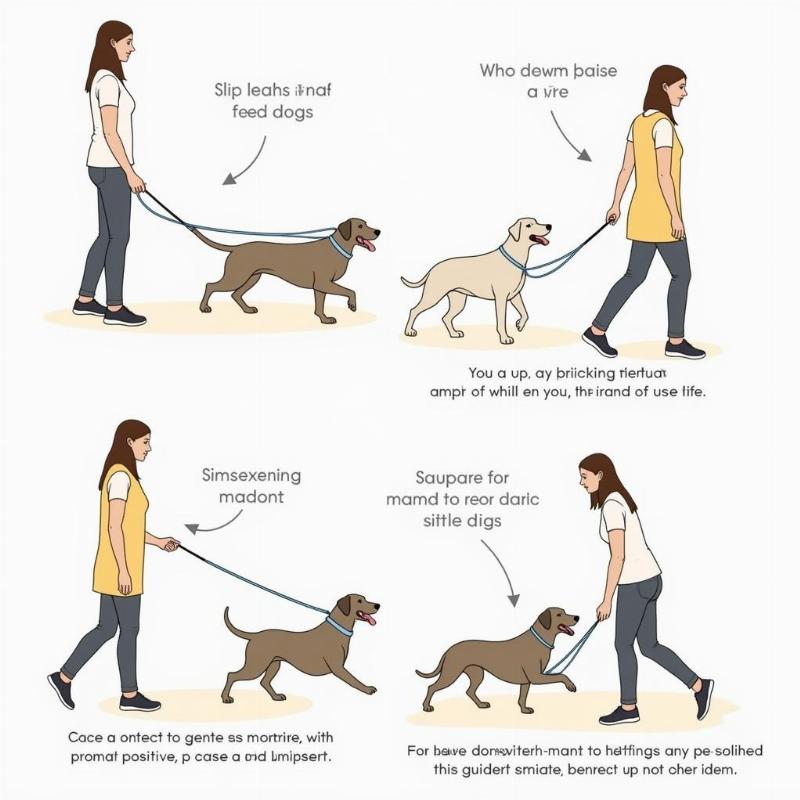Slip leashes are a popular tool for dog training, offering control and guidance. They are particularly useful for teaching leash manners and basic obedience. Understanding how to properly use a slip leash is crucial for effective training and your dog’s safety.
Understanding the Slip Leash
Slip leashes, also known as training leashes or slip leads, are a single loop of rope or nylon designed to tighten gently around a dog’s neck when pulled. This tightening action provides feedback to the dog, discouraging pulling and promoting loose-leash walking. However, misuse can lead to choking or injury, so proper technique is essential. This guide will cover the benefits, risks, and best practices for using a slip leash effectively and safely in the United States.
Benefits of Using a Slip Leash for Dog Training
Slip leashes offer several advantages in dog training:
- Control and Guidance: They provide quick and effective control, especially helpful with energetic or easily distracted dogs.
- Leash Manners: The gentle tightening action discourages pulling, promoting loose-leash walking and reducing strain on both dog and owner.
- Basic Obedience: Slip leashes can aid in teaching commands like “heel” and “sit” by providing clear communication and direction.
- Convenience: Lightweight and easy to carry, they are a practical tool for everyday training sessions and walks.
Risks and Precautions When Using a Slip Leashes
While slip leashes can be effective, improper use carries risks:
- Choking Hazard: If used incorrectly or left too loose, a slip leash can become a choking hazard, especially for small breeds or puppies.
- Neck Injuries: Jerking or constant pressure can cause neck injuries. Never use a slip leash on a dog with tracheal problems.
- Negative Associations: Harsh corrections can create fear and anxiety, hindering the training process and damaging the dog-owner bond.
Choosing the Right Slip Leash
Selecting the appropriate slip leash is important for your dog’s safety and comfort:
- Material: Nylon is durable and easy to clean, while rope offers a softer feel but may fray over time.
- Thickness: Choose a thickness appropriate for your dog’s size and strength. A thin leash may be uncomfortable for larger breeds.
- Adjustability: Ensure the leash can be adjusted to fit your dog’s neck snugly but not too tight.
How to Properly Use a Slip Leash
Proper technique is crucial for safe and effective slip leash training:
- Placement: Position the leash high on the dog’s neck, just behind the ears. Avoid placing it lower on the neck, as this can restrict breathing.
- Fit: The leash should be snug but not tight. You should be able to fit two fingers comfortably between the leash and your dog’s skin.
- Gentle Corrections: Use short, gentle tugs to redirect your dog’s attention, avoiding harsh jerks or constant pressure.
- Positive Reinforcement: Reward desired behavior with praise, treats, or toys to create positive associations with the leash.
 Proper Slip Leash Technique
Proper Slip Leash Technique
When Not to Use a Slip Leash
Avoid using a slip leash in the following situations:
- Puppies under 6 months: Their necks are delicate and prone to injury.
- Dogs with tracheal problems: A slip leash can exacerbate breathing difficulties.
- Untrained owners: Improper use can cause harm. Seek professional guidance if you’re unsure about proper technique.
- Long-term use for everyday walks: For regular walks, a standard leash and harness are generally recommended for comfort and to avoid potential neck strain.
Alternatives to Slip Leashes
Consider these alternatives for everyday walks and long-term leash training:
- Standard Leash and Collar: A basic but effective option for walks with well-behaved dogs.
- Harness: Distributes pressure evenly across the chest, reducing strain on the neck. Especially suitable for dogs who pull.
- Head Halter: Gently guides the dog’s head, offering control and discouraging pulling.
Conclusion
A slip leash can be a valuable tool for dog training when used correctly. Remember to prioritize your dog’s safety and well-being by following the guidelines outlined in this comprehensive guide. Proper fit, gentle corrections, and positive reinforcement are key to successful slip leash training. For everyday walks, consider alternatives like a standard leash and harness for long-term comfort and to prevent potential neck injuries.
FAQ
- Can I leave a slip leash on my dog unsupervised? No, never leave a slip leash on a dog unsupervised, as it poses a strangulation hazard.
- What size slip leash should I get for my dog? The size depends on your dog’s breed and neck circumference. Consult a pet store professional for guidance.
- Is a slip leash suitable for all dog breeds? While generally safe for most breeds, avoid using slip leashes on brachycephalic breeds (e.g., Bulldogs, Pugs) due to their breathing difficulties.
- How do I transition from a slip leash to a regular leash? Gradually introduce the regular leash during training sessions, rewarding your dog for walking calmly on both.
- Can a slip leash be used for puppies? Generally, it’s best to avoid using slip leashes on puppies younger than six months due to their developing necks.
- What should I do if my dog coughs or gags while wearing a slip leash? Loosen the leash immediately and ensure it’s fitted correctly. If the problem persists, consult a veterinarian or professional dog trainer.
- Are there any legal restrictions on using slip leashes in the US? While there aren’t federal laws, some local ordinances may regulate leash types. Check your local regulations.
Related Articles
Beautdogs.us is your premier resource for all things dog-related in the United States. We offer expert advice on dog breeds, care, training, and product recommendations. Whether you’re a seasoned dog owner or just starting out, Beautdogs.us is your trusted source for comprehensive and engaging information to help you navigate the joys and responsibilities of dog companionship. For inquiries, contact us at [email protected] or call us at +1 501-555-7529. Visit Beautdogs.us today!